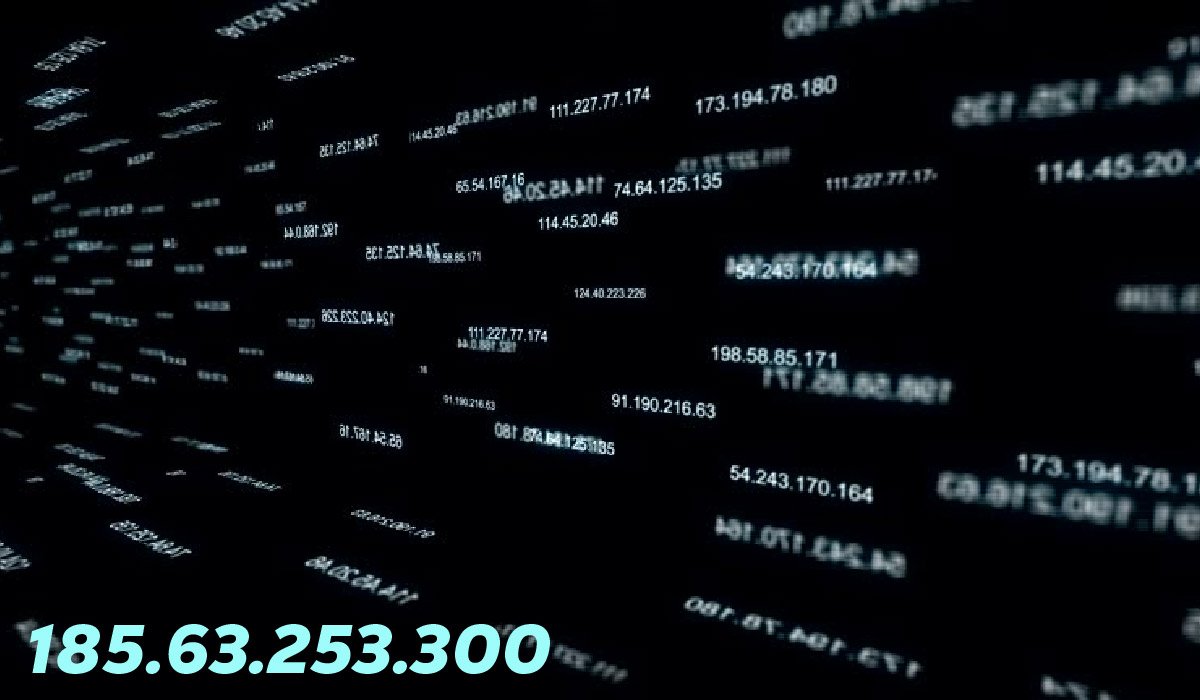Blog
185.63.253.300: The Invalid IP That Reveals a Shocking Truth

Introduction
In the massive machinery of the internet, IP addresses function as essential gears that keep digital communication flowing seamlessly. These strings of numbers, though often overlooked by casual users, play a foundational role in everything from opening a website to sending an email. One particular IP address, “185.63.253.300,” has captured attention—not because of what it does, but because of what it represents.
Technically invalid, due to the final octet exceeding the acceptable range of 255, this IP address presents a fascinating paradox: meaningless in execution, yet powerful in implication. In this article, we explore “185.63.253.300” not just as a miswritten technical string, but as a mirror into our digital habits, cybersecurity assumptions, and the very nature of network communication. From technical breakdowns to philosophical and environmental metaphors, this article takes a comprehensive look at a seemingly broken number and discovers meaning beyond the digits.
What Is an IP Address?
An Internet Protocol (IP) address is the digital equivalent of a postal address. It is a unique string of numbers assigned to every device connected to a network that uses the internet. These addresses serve two essential purposes: identifying the host or device and specifying its location within the network. Without IP addresses, data wouldn’t know where to go, making online activities impossible.
IP addresses come in several varieties, including public and private, static and dynamic. Public IPs are visible to the internet and used for external communication, while private IPs function within internal networks like homes or offices. Static IPs remain constant, whereas dynamic IPs can change periodically based on the ISP’s configuration. The IP address “185.63.253.300” falls under the IPv4 format at first glance but fails the technical test, offering a unique teaching moment on what these addresses really mean.
IPv4 Address Format and Why “185.63.253.300” Is Invalid
IPv4 addresses are structured in a four-octet format, each separated by a period. Each octet contains an 8-bit number, allowing for a range from 0 to 255. A valid IPv4 address looks like this: 192.168.1.1. When you inspect “185.63.253.300,” the issue becomes immediately apparent—the last octet, 300, exceeds the allowable maximum of 255. This makes the entire address invalid within the scope of IPv4 standards.
This strict formatting exists for a reason: it ensures predictable, organized communication across global networks. Invalid formats like “185.63.253.300” may be harmless in theory but could cause serious issues in systems where validation is overlooked. These mistakes can corrupt logs, trigger false alarms in cybersecurity systems, or even expose gaps in validation filters. The very presence of this invalid address in digital systems serves as a reminder of how fragile and meticulous network structures really are.
Evolution from IPv4 to IPv6
IPv4 was created in the early days of the internet and offered around 4.3 billion unique addresses. At the time, this number seemed more than adequate. However, with the explosion of internet-connected devices—phones, laptops, smart TVs, IoT sensors—the pool of available IPv4 addresses quickly depleted. To address this shortage, IPv6 was introduced, offering an astronomical 340 undecillion possible addresses.
While IPv6 solves the problem of scarcity, the world has been slow to adopt it fully. Legacy systems, software incompatibilities, and the inertia of existing infrastructure mean IPv4 remains dominant even today. Addresses like “185.63.253.xxx” are still in widespread use for websites, VPNs, and cloud servers. Although “185.63.253.300” doesn’t technically exist, its first three octets fall within valid European-assigned blocks, making it appear plausible at first glance. This confusion between valid appearance and invalid content is one of the reasons it garners attention.
What IP Addresses Can and Cannot Reveal
There’s a widespread misconception that an IP address can pinpoint someone’s exact identity or location. While IP addresses can offer clues, they are far from definitive. They can usually reveal a user’s approximate location, such as city or region, and identify the Internet Service Provider (ISP). T
hey may also indicate the type of device or network—a mobile user, a business network, or a residential line. However, an IP address cannot reveal personal details like a person’s name, exact address, or browsing habits without deeper forensic investigation and ISP cooperation. This misunderstanding has fueled myths in pop culture and even law enforcement errors. Invalid addresses like “185.63.253.300” add another layer of confusion, as they may appear in logs or alerts and lead investigators down dead-end paths.
“185.63.253.300” in Logs, Scripts, and Firewalls
Despite being invalid, addresses like “185.63.253.300” do show up in various digital environments. Developers sometimes use them as dummy values in scripts, test cases, or placeholder content. Cybersecurity professionals have found such malformed addresses in firewall logs, indicating failed connection attempts or spoofed input data. Intrusion detection systems (IDS) and Security Information and Event Management (SIEM) platforms often flag these as anomalies worth reviewing.
The appearance of “185.63.253.300” in any system should prompt a closer look: Is it a developer’s mistake? A misconfigured system? Or something more malicious? Recognizing the contexts where invalid IPs emerge can help organizations avoid false positives while remaining vigilant about real threats.
Cybersecurity Risks of Invalid IPs Like 185.63.253.300
Cybercriminals often employ malformed IP addresses in their attack strategies. In DDoS attacks, for instance, spoofed or invalid IPs are used to flood targets with meaningless traffic. This not only disrupts service but also confuses traffic analysis tools. Similarly, fake IPs like “185.63.253.300” may be used to test the robustness of firewalls or validation systems.
A failure to properly filter these inputs could allow malicious actors to inject harmful payloads or bypass certain security rules. For organizations, the appearance of such IPs is a cue to audit their input validation, log filtering, and monitoring systems. Ignoring malformed IPs as mere anomalies can leave open windows for exploits.
Developer & Testing Use Cases
In software development and QA testing, developers often use fake data to simulate real-world conditions without risking actual data leaks. “185.63.253.300” is the kind of value that might be found in automated test scripts, firewall rule tests, or UI validation exercises. Because it is technically invalid, it provides a safe example that won’t accidentally connect to a real-world server. It helps developers ensure their applications handle malformed or incorrect input gracefully. Using invalid IPs like this is considered a best practice in environments where unpredictable input must be anticipated and accounted for.
AI & IP Analysis in Modern Cyber Threats
With the rise of AI-driven cybersecurity, detecting and analyzing patterns in IP traffic has become more efficient and accurate. Machine learning models are trained to identify suspicious behavior, including the use of malformed IP addresses like “185.63.253.300.” When AI systems detect such patterns, they flag them for deeper inspection, helping threat analysts determine whether they are random anomalies or signs of a coordinated attack. These tools are also used to track botnets that use randomized or spoofed IPs to hide their origin. By training on both valid and invalid data, AI becomes a more robust line of defense.
Eco-Metaphor: 185.63.253.300 as Digital Pollution
While “185.63.253.300” doesn’t pollute the air or water, it does represent a kind of digital waste. Invalid IPs that remain in logs, unused scripts, and security alerts add to the clutter of the digital world. Storing and managing this data consumes real-world energy via data centers that require electricity and cooling systems. Just like physical litter clogs ecosystems, digital litter clogs databases, analytics dashboards, and backup systems. This metaphor reminds us of the environmental cost of our digital infrastructure. Responsible developers and administrators should routinely clean logs, delete outdated configurations, and practice digital minimalism.
IP Myth-Busting: Debunking Pop Culture and User Beliefs
Popular culture has greatly distorted the power of an IP address. Movies show hackers instantly tracking people across the globe using nothing but an IP, while crime dramas suggest that locating a suspect is just a click away. In reality, IP tracking is approximate at best and riddled with complications. Many devices share the same IP through NAT (Network Address Translation), and dynamic IPs change frequently. “185.63.253.300,” used in a fictional scene, would immediately fail because it’s invalid—but the average viewer wouldn’t know that. Clarifying these myths helps create a better-informed public and more secure network practices.
How to Validate or Lookup an IP Address
Validating an IP address is easier than ever with online tools like IPWhois, IPLocation.net, or AbuseIPDB. These platforms allow users to input an address and receive information about its location, ISP, and historical behavior. From the command line, tools like ping, traceroute, and nslookup can provide technical feedback about connectivity. In the case of “185.63.253.300,” these tools will return errors, indicating it cannot be reached. Reverse DNS lookups also fail, reinforcing its invalidity. Nonetheless, learning how to validate IPs properly is a critical skill for IT professionals, cybersecurity analysts, and even general users.
What Happens When You Try to Ping 185.63.253.300?
Attempting to ping “185.63.253.300” from any device will result in an immediate failure. The system will either correct the input or return a message such as “Ping request could not find host.” Similarly, a traceroute will show that the address cannot be resolved. These results are expected due to the invalid final octet. Despite this, such tests are valuable because they confirm the IP’s status, helping users eliminate it from legitimate use cases or identify it as an anomaly in logs or traffic patterns.
Best Practices for Handling Malformed IPs
Organizations and developers must treat malformed IP addresses seriously. This begins with strong input validation—ensuring that only properly formatted addresses are accepted in forms, logs, or configuration files. Regex filters should be implemented to block octet values beyond 255. Security teams should also establish monitoring rules to flag and review invalid IPs as part of routine threat detection. Log management systems should be configured to filter out or quarantine malformed entries, reducing clutter and preventing misinterpretation. Education is also critical; all stakeholders should understand the potential risks posed by ignoring malformed IPs.
Symbolic Meaning of 185.63.253.300 in the Digital World
Beyond its technical invalidity, “185.63.253.300” symbolizes a host of issues in the digital age. It stands for broken systems, forgotten data, and the fine line between functionality and chaos. In cybersecurity, it represents a gap—an oversight that can be exploited. In development, it reflects human error and the importance of strict standards. Philosophically, it’s a reminder that even meaningless data can teach meaningful lessons. Its symbolic value lies in its ability to provoke thought about how we treat digital systems and what we expect from them.
Bonus: If 185.63.253.300 Were Earth
Let’s imagine “185.63.253.300” as Earth itself—just one node in a massive interstellar network. What if the planet was sending out error messages, like an invalid IP? Climate change, rising sea levels, extinction events—these are the pings, the traceroutes gone unanswered. As stewards of this system, humans are the administrators. Just like we should validate IPs and clean digital logs, we must maintain Earth’s ecosystems and listen to its alerts. This metaphor turns a failed address into a poetic call to environmental awareness, emphasizing the interconnectedness of all systems—digital and natural.
Conclusion
“185.63.253.300” began as a mistake—a malformed IP address. But in exploring its implications, we uncover a microcosm of the internet’s complexity, fragility, and symbolism. From its use in developer sandboxes to its potential misuse in cyberattacks, this address illustrates how even the smallest errors can ripple across systems. As we transition from IPv4 to IPv6 and integrate AI into cybersecurity, understanding the nuance behind such anomalies becomes even more critical. Ultimately, “185.63.253.300” is more than a failed string of numbers—it’s a lesson in precision, a metaphor for decay, and a call to treat both our digital and physical worlds with greater care and intentionality.
FAQs About 185.63.253.300
What is 185.63.253.300?
185.63.253.300 is an invalid IPv4 address because the last number (300) is too high. IPv4 addresses must have four numbers, each between 0 and 255. Since 300 is not allowed, this IP address does not work on the internet.
Why is 185.63.253.300 not a valid IP address?
This address is not valid because the last section (called an octet) is 300, and IPv4 rules only allow numbers from 0 to 255. Any number above 255 makes the entire address incorrect.
Can an IP address like 185.63.253.300 cause security problems?
Yes, invalid IP addresses like 185.63.253.300 can appear in hacking attempts or testing tools. Hackers may use fake IPs to trick systems or test for weak security settings, so it’s important to monitor and filter them.
What happens if I try to ping 185.63.253.300?
If you try to ping 185.63.253.300, your system will return an error. That’s because it cannot find or connect to an address that doesn’t exist. It’s similar to typing the wrong phone number—you won’t reach anyone.
Why does 185.63.253.300 show up in logs or code?
185.63.253.300 might appear in logs or software as a placeholder, test value, or by mistake. Developers sometimes use fake IPs for testing, or someone may have typed it incorrectly in a configuration.
For More Information Visit Coopermagazine
-

 Celebrity1 year ago
Celebrity1 year agoWho Is Jennifer Rauchet?: All You Need To Know About Pete Hegseth’s Wife
-

 Celebrity1 year ago
Celebrity1 year agoWho Is Mindy Jennings?: All You Need To Know About Ken Jennings Wife
-

 Celebrity1 year ago
Celebrity1 year agoWho Is Enrica Cenzatti?: The Untold Story of Andrea Bocelli’s Ex-Wife
-

 Celebrity1 year ago
Celebrity1 year agoWho Is Klarissa Munz: The Untold Story of Freddie Highmore’s Wife
















